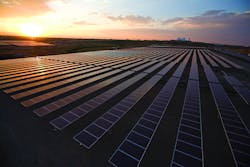Comments Woods Allee, director of capital planning and special projects at Denver International Airport (DIA), “In 2001, the state passed a statute with an RES (renewable energy standard) which required some incentives on the part of the State with regard to solar. We’ve kept a close eye on what was being developed in terms of photovoltaic (PV) technology.”
PV technology takes solar energy and converts it directly to electrical energy, says Allee.
“The airport chose that technology because the RES specifically recognized PV, and from our perspective, given our real business of operating an airport, we are going to be very careful in deploying any technology that requires reflectors; that’s a safety issue related to a pilot’s visibility,” he adds.
“We went through quite an effort with FAA because we have the largest installation of solar I think of any airport in the country, and we were the first to do a major solar installation at a major airport. The FAA was very interested in how we went about doing this, and demonstrating to themselves primarily that there was a low risk of any interference with air navigation."
The airport went through an RFP to select a firm to help develop a bid.DIA worked closely with FAA to sort out visibility and glare issues; a number of tests were conducted in 2006.
“Ultimately, FAA flight standards agreed that there was not a high risk in terms of pilot visibility, and we got approval of FAA form 7460 (site plan and land lease & operating agreement approval process) for the three different systems we have now.”
Energy savings
There are a significant number of tax incentives that private tax-paying entities can take advantage of, and that would be very difficult for the airport to take advantage of, explains Allee. "So it turns out that the cost of funds ultimately to the airport, even if we use tax-exempt bonds and our high credit rating, is lower for a private entity than it is for us to do this directly through our own bonds … hence the public-private partnerships that we’ve entered into.
"We have two agreements with regard to the two existing solar projects: a ground-lease agreement which conveys certain rights to the developer- the developer wants to be sure they have rights to the land for the next 20 years, and that we don’t build something that will shade the land; the other agreement is a power-purchase agreement (PPA) – where we essentially agree to buy the power that the developer generates from the projects."
"Our capital outlay for all three solar projects really has been nothing - it’s all paid for by private investors who will reap the benefits of the tax incentives.
DIA Solar One was built when panel costs were fairly high; the overall cost to construct that system was about $13.5 million, and consists of ? panels, says Allee. DIA Solar Two cost about $7 million, and there are some 7,300 panels.
Existing solar installations
Solar is good for DIA, explains Allee, because there is more than 300 days of sun here each year; he the State’s RES created incentives for people to be able to build economic solar facilities.
“Xcel Energy [a large Midwest electric utility] charges a rider on our electrical bills, and some 1 percent of that money goes into a pot to incentivize renewable energy,” he relates.
“The way you bid into the program is you sell the renewable energy component back to Xcel; they buy that component from the generation source.”
The airport has a couple of opportunities, says Allee. One, there is 33,800 acres here … a large land area, much of which is going to remain unused for a length of time. “We also have significant energy loads here; we are Xcel’s largest single load in this region,” he remarks. “So that load factor in proximity to available land makes the airport attractive for ground-managed solar technology - those factors help keep the costs down.”
The airport currently has three solar projects - two that have been completed and are operating. DIA Solar One was commissioned in Sept. 2008; and DIA Solar Two provides all of the energy for the airport’s fuel farm, meaning the fuel storage and distribution system is operated on solar-generated energy. DIA Solar Three is now under construction.
"Solar energy currently generates about 2.5 percent of our overall annual energy consumption, says Allee. "We draw about 219 million kilowatt-hours of electricity per year at the airport. We get about 3.3 million kilowatt-hours per year from DIA Solar One, and about 2.5 million from DIA solar Two. Solar Three should generate close to 8 million kilowatt-hours per year; that should put us close to the 5 percent range of our total load being renewable energy.
"Our objective is to generate more renewable energy here; we’d like to get to the 20 percent range."
For DIA Solar One (a 7.5 acre single-access tracking system) the power purchase agreement (PPA) is a fixed-rate per kilowatt hour for the first five years, says Allee.
"The way that stands now, we buy the power from the developer at 6 cents a kilowatt hour, we sell it back to Xcel at their annual incremental cost of fuel," he relates.
"Our expectation is if power costs escalate at 3 percent or more over the next 20 years, we will save money. There is a risk element involved, but we did look at the historical rate for power prices over the last 20 years, and they’ve escalated at some 3.8 percent."
With DIA Solar Two (also some 7.5 acres; a 25-degree fixed tilt system), again there is a ground-lease and a PPA involved. The PPA sets a floor of 3.7 cents per kilowatt hour, "So we buy the power from the developer at the greater of 3.7 cents per kilowatt hour, or 90 percent of tariff," says Allee.
"We’ve now had that operating for about a year. Over the first year we saved a few thousand dollars.
Solar three
Remarks Allee, "We worked with Oak Leaf on all three projects in varying capacities; they were the developer on Two and Three. MP2 is the financial entity that is the owner and operator of DIA Two; Constellation Energy is going to be the owner/operator of DIA Three."
Solar Three will be some 4.5 megawatts, a little more than twice the size of the original two installations combined.
The new installation is modeled after the Solar Two deal - 3.7 cents per kilowatt hour, or 80 percent of tariff. The projectg will cover some 28-acres, and will be a 25-degree fixed tilt system.
Construction on Solar Three began in September of last year, and Allee expects the installation to be complete by June of this year.
Sustainability at Denver International
Comments Woods Allee, "While solar is probably the most visible thing we do, I think we have one of the most active sustainability programs in the country; and we are the only major airport that I know of that is 14001 ISO-certified – in other words we have an EMS (environmental management system) that covers solid waste, energy use … essentially the entire sustainability concept."
"Our basic tenant has always been, we are going to do this in a way that makes economic sense for the airport; we are going to create value for the airport in today’s terms.
"At the same time, we are doing the right thing from an environmental standpoint.
"The second thing is we want to make sure that we leave room for future technologies … so we’re not going to go out and get that 20 percent entirely with photovoltaic technology because I think there is going to be some new technologies in the next five years that will be even better.
"In the mean time we continue to invest money in energy management, and reducing the amount of energy we consume. One example of that is implementing a power management system for our movable walkways and escalators."
About the Author

